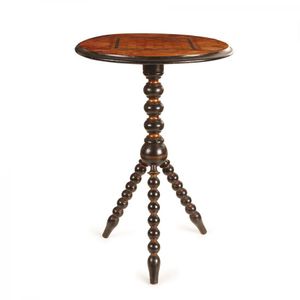18th Century Brass Lantern Clock by Robert Coster
An early 18th century brass lantern clock by Robert Coster of Newbury with bell over dolphin fret and four urn finials, Doric corner columns on turned feet, oversailing Roman chapter ring enclosing engraved makers name 'Robert Coster, Nenbery' (sic). Converted mechanism, pendulum and weights absent), height 40 cm. Coster was apprenticed to Luke Wise of Reading in 1695 and worked there until 1707 where after he relocated to Newbury, he died in 1749.
You must be a subscriber, and be logged in to view price and dealer details.
Subscribe Now to view actual auction price for this item
When you subscribe, you have the option of setting the currency in which to display prices to $Au, $US, $NZ or Stg.
This item has been sold, and the description, image and price are for reference purposes only.
- Finial - An architectural decoration, found on the upper parts of of an object. On furniture they are usually found on pediments, canopies and shelf supports. On smaller ceramic or silver items, such as spoons, they may decorate the top of the item itself, or the lid or cover where they provide a useful handle for removal.
Finials have a variety of shapes and forms. They may be urn-shaped, baluster shaped round or spiral, but usually taper into an upper point. Many real life shapes may also be used as finials, such as pineapples, berries, pinecones, buds, lotus and acorns. Sometimes animals such as a lion are depicted, or fish and dolphins. - Chapter Ring - A separate metal plate on the face of a clock, on which the numerals for the hours and sometimes parts of the hours, are displayed, usually wheel shaped and sitting on top of the dial plate. The chapter ring is often a feature of the clock and can be silvered or enamelled to stand as a contrast to its background. The hours are usually shown in Roman numerals, although in the late 19th and earlt 20th century, Arabic numerals became fashionable.
- Pendulum - The pendulum was discovered around 1602 by Galileo Galilei, and was adopted for time keeping by the Dutch mathematician and natural philosopher, Christiaan Huygens, who excelled in astronomy, physics, and horology.
The pendulum comprises a metal rod usually of brass or steel with a metal disk, known as a bob, at the end. The movement of the pendulum is driven by weights or a spring, and as a pendulum swings in a regular arc, it was found accuracy could be controlled to within a few seconds a week.
Timekeeping can be adjusted by changing the height of the bob on the rod, making the pendulum either swing slower or faster.
The disadvantage of the pendulum was that changes in temperature also changed the length of the pendulum, interfering with the accuracy of the clock, and so in the 18th century two types of mercurial pendulums were invented which countered the movement in the steel rod.
The pendulum was the world's most accurate timekeeping technology until the invention of the quartz clock, regulated by a quartz crystal, in 1927.
This item has been included into following indexes:
Visually similar items

Antique Chesterfield settee upholstered in yellow deep button leather
Sold by
in
for
You can display prices in $Au, $US, $NZ or Stg.

Cloisonne porcelain shoulder vase, approx 31 cm high
Sold by
in
for
You can display prices in $Au, $US, $NZ or Stg.

An inlaid New Zealand Native Woods chess table, with gypsy bobbin turned base. C.1890. Height 72 cm, diameter 50 cm
Sold by
in
for
You can display prices in $Au, $US, $NZ or Stg.

Good pair of swan form French bronze marble topped side tables, 69 cm high
Sold by
in
for
You can display prices in $Au, $US, $NZ or Stg.
